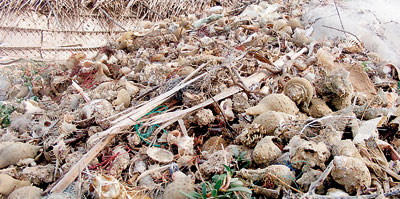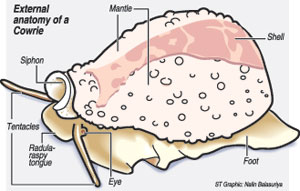News
Huge shell-creatures dragged out live to satisfy foreign demand
View(s):By Malaka Rodrigo
Foot-long helmet shells were among rare and protected species found being smuggled out of Sri Lanka as worries grow that demand for perfect shells is leading to a disturbing practice of wresting the molluscs live from the seabed for big money from buyers. A Chinese male nabbed at Katunayake airport on April 2 had nine shells a foot in diameter, among them some of the most highly-valued and rare species, according to Samantha Gunasekara of the Customs’ Biodiversity Unit.

A graveyard for shells. Pic by Upali Malikarachchi
The culprit, a worker at the Norochcholai Power Plant, was given a warning before being released. The shells were confiscated.
Mr. Gunasekara told the Sunday Times there appeared to be an increasing demand for Sri Lankan shells in foreign markets. Last week, this paper reported that coral and shells found on March 28 in the baggage of three Chinese working at Mattala Airport had been skilfully dug up from the seabed, suggesting that an organised operation was at work.
In October last year, another man was found trying to smuggle out high-value shells. It was a well-planned shipment that indicated the demand for Sri Lankan shells had given rise to organised smuggling attempts, Mr Gunasekara said.
Prasanna Weerakkody; a marine naturalist, said it was unlikely that the helmet and spider shells found in the April 2 smuggling attempt had been washed ashore and collected legally. He believes the prime condition in which they had been found indicates they had been collected by divers from the sea bed.
Creatures with large shells mostly live in deeper sea, and by the time their shells get washed ashore, they get marked eing tossed and rolled along the ocean bed by the currents over a long distance and from collision with coral beds and other submarine obstacles.
When the shells are collected live they are piled on land or buried together with other shells, and the creatures within eventually die.
Mr. Weerakkody believes that people diving for sea cucumber, ornamental fish or chank (conch) shells are also now collecting the large helmet and spider shells.
Shanaka of Kalpitiya, who makes a living diving for sea cucumber and chank, said helmet and spider shells had not previously been collected on a commercial scale because they had not been in great demand. That was changing, he disclosed. The Chinese brought to work on the Norochcholai power plant were keen to obtain these shells.
While Shanaka made assurances that large shells such as helmet shells could still be seen on the sandy sea floor in deeper ocean, he also emphasised that divers react to demand in collecting shells for sale. The revelations send an important message that the authorities should be vigilant about this trend.
Experts warn tourism could create more demand for shells and that divers would increasingly resort to collecting the shells live from the seabed rather than harvesting them when they are washed ashore.
In popular tourist destinations such as Hikkaduwa or Kirinda there are many shops selling a variety of shells. Although they do buy shells found on beaches, they offer suppliers a higher price for shells collected live because of their prime condition.
An expert on aqua-life attached to Wayamba University, Dr Sewvandi Jayakody, said that on March 31 she had found a youth collecting live cowries from the reef at Hikkaduwa. (The cowrie is a gastropod snail that makes the kind of speckled decorative shell used for the Avurudu game of pancha).
The boy she had accosted had the pockets of his three-quarter trouser full of cowrie shells, and her query he said he had only been collecting dead cowries. On inspection, however, Dr Sewvandi had found live cowries, including a tiger cowry – a species in high demand.
When she threatened to inform the police, the youth had thrown the live cowries back into the sea.
Dr Sewvandi raised alarms about collection of live shells, saying this would be particularly dangerous for threatened species.
Already the conch – a gastropod species that makes chank shells – is decreasing in many areas due to over collection. Chank is the famous shell used as a musical instrument in traditional cultural events. The shell of this mollusc is the famous “hak gediya” (conch) played at traditional events.
Amazing seashells
Seashells are calcareous external coverings, or external skeletons, of two groups of marine Mollusks – gastropods or snails, which have shells formed in spirals, and clams or bivalves, with shells in two halves joined by a hinge, explains Dr Malik Fernando in his book “Shells of the Sri Lanka Seashore”.

Gastropods – the name means stomach-footed – are molluscs that creep along using a muscular, disc-shaped foot. Their soft bodies can retract for protection into the shell attached to the body.
Dr Fernando, who has also compiled a Provisional Checklist of Marine Aquatic Shelled Molluscs of Sri Lanka for the National Red List 2012 of Threatened Fauna and Flora, says there are more than 500 gastropod snail species in our oceans, but says the number should be much higher. Literature shows that gastropods are extremely diverse, with more than 40,000 species worldwide.
Mantle tissue located under and in contact with the shell secretes proteins and mineral extra-cellularly to form the shell. Seashells grow from the bottom up, or by adding material at the margins. Since their exoskeleton is not shed, mollusc shells must enlarge to accommodate body growth.
Collecting shells has been a popular pastime. But if there is something protruding from the opening, or you see a hard cover over the opening, this means it is still occupied. “Take a photo and leave the little guy where you found him,” advises Dr. Fernando.
Follow @timesonlinelk
comments powered by Disqus














